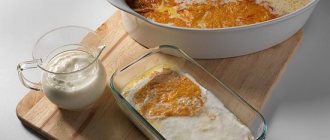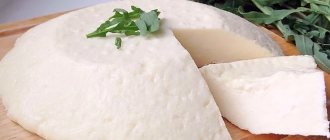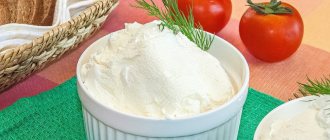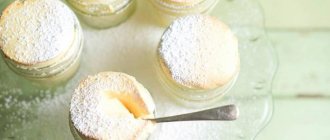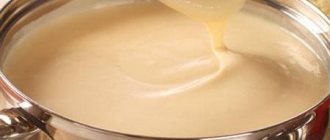Useful tips for making cottage cheese at home
I’ll tell you the secrets of homemade cottage cheese made from milk:
- You should not take ultra-pasteurized milk (it has a long shelf life). Such milk will not make healthy homemade cottage cheese.
- In no case should milk be overheated above 40-43 degrees. In this case, the cottage cheese will be rubbery or with hard grains.
- It is advisable to use whole milk - not pasteurized or pasteurized by simple pasteurization.
- If you take store-bought milk, it is better not to take milk with a fat content of 1%. The best cottage cheese is made from milk with a fat content of more than 2.5%.
- Milk for cottage cheese must be mature. For example, if the milk is fresh, then you need to leave it in the refrigerator for 2-3 days, and then use it for cottage cheese.
- Whole milk contains all the beneficial microelements that are so beneficial and nutritious for the body.
- Under no circumstances should milk sit on cottage cheese and sour for several days!
- Under no circumstances should the cottage cheese drip and remain suspended for several days!
What is cottage cheese and what types does it come in?
The meaning of the word “cottage cheese” includes the concept of “milk made solid.”
This is a fermented milk product that is made by humans by fermenting milk. In modern Russian, the words cottage cheese and cheese have different meanings. But before everything was called one word “cheese”. Dishes made from cottage cheese were called “cheese”. Some names of products with a similar ingredient still exist, but are perceived differently. The British consider it a soft young variety of cheese.
It is customary to classify cottage cheese according to fat content:
- low fat;
- low-fat;
- classical;
- fatty.
According to the method of preparation, cottage cheese is divided into traditional and separate. According to the method of coagulation of milk proteins, traditional milk is divided into acid and acid-rennet. The first is prepared from skim milk, which sours under the influence of starter cultures. And the second involves the simultaneous use of pepsin and starter culture.
With the separate method of preparing cottage cheese, purified milk is separated for defatting. A granular mass is obtained from it, which is mixed with cream.
Industrial production of cottage cheese
The principle of making cottage cheese at home differs from industrial production. This includes milk normalization, pasteurization and transfer to special containers. There the milk is kept at a temperature of 28-30°C.
During the cooking process, pepsin and sourdough are added. After about 8 hours, curd grains appear in the container and the whey is separated. The grain is pressed out and cooled. After this process, the product is packaged.
The value of cottage cheese
Protein is the main wealth of cottage cheese. It is necessary for the full development of the body. With its help, the nervous system and bones are strengthened, and the body receives prevention from atherosclerosis. The product is useful for diabetes, neuroses, and gastrointestinal diseases. Children, the elderly and pregnant women can benefit greatly.
Cottage cheese helps normalize the intestinal microflora and suppress the growth of putrefactive bacteria. It is much easier to digest than other fermented milk products. It provides complete nutrition during recovery from illness. For example, it is useful to eat granular mass for bone fractures, rickets, diseases of the kidneys and hematopoietic apparatus.
The uniqueness of the product lies in the content of those minerals that are needed for the production of hemoglobin. This is an indispensable product when losing weight and building muscle mass. You just need to know what can be made from cottage cheese so that the menu is varied and equally healthy.
Harm of cottage cheese
The fermented milk product under discussion causes trouble to the body only when its storage conditions or the tightness of the packaging are violated. This threatens serious poisoning and allergic reactions.
After opening the package, you can store the cottage cheese for no more than three days. When purchasing, pay attention to the production date.
Benefits for children
Cottage cheese is introduced into complementary foods for children after 6 months of life. It promotes the proper development of the skeletal system of children, ensures proper functioning of the intestines, and the development of healthy teeth. An incredibly healthy product made from goat milk. It is hypoallergenic because it does not contain lactose.
In many countries, goat milk cottage cheese is used as a medicine in the treatment of gastritis. Our stores cannot boast of selling such a product. A young mother can know how to make cottage cheese from milk herself.
Homemade cottage cheese from milk
This recipe for homemade cottage cheese made from milk is universal. It produces tasty, tender and non-sour cottage cheese. It is prepared very quickly and simply.
To make homemade cottage cheese you will need:
- Whole milk – 3 liters.
- Pan or jar.
| 1. Take a can of whole milk. I have cream collected at the top of the jar, I separate it and make sour cream from it or add it to desserts. The cream is removed in order to obtain low-fat, low-calorie cottage cheese. | |
| 2. Heat the milk to 35-40 degrees. I use a food thermometer, but you can use your little finger to feel the milk is slightly warm. Place the milk in a warm place (closer to the radiator or closer to the stove) and leave it overnight (or for 12 hours if you started making cottage cheese early in the morning). Cover the container with milk with either gauze or a waffle towel so that it can breathe. | |
| 3. In the morning, a curd clot forms - dense and white. Without disturbing it, carefully cut it into large squares. | |
| 4. Place two layers of gauze or fabric such as lavsan, veil or organza in a colander and carefully dump the clots onto it and let it drain. It is advisable that the temperature in the room should not be higher than 24 degrees. If the room is very hot, then you need to leave the curd to drain in a cooler room, maybe on the balcony or outside. | |
| 5. Next, hang the cottage cheese so that the whey flows into the container. This is the light transparent yellow color that the whey from cottage cheese turns out to be. It’s incredibly delicious to use for making yeast dough for pies, buns or pizza, kneading thin pancakes, and preparing any pastries. The serum is also good for the skin; it can be used as a softening lotion. | |
| 6. After about 10-12 hours, the cottage cheese is ready. | |
| 7. This cottage cheese is very tasty, tender, suitable for desserts, for baking, and for filling pancakes. | |
| 8. You can also simply eat cottage cheese prepared at home, mixed with a banana or other berries: or topped with jam or condensed milk. |
The cottage cheese according to this recipe is not sour, very tasty, milky.
Cottage cheese starter recipe
- Take regular skim milk from fresh, unheated whole milk and place it in a warm place for natural fermentation.
- From the resulting curdled milk, cook the cottage cheese over low heat, stirring constantly, until the curdled milk begins to shrink and form lumps. Here, turn off the gas and let it sit for another 5 minutes.
- Throw the cottage cheese through a sieve or lavsan, let it flow a little
- Rinse the resulting curd with cold water.
- Leave to flow around, squeeze or press; customers are very picky about the presence of liquid in the corners of the package with cottage cheese.
Washing with water will not worsen the taste, but will stop the souring process, as it will lower the temperature of the product and remove excess whey that gives acidity. Cottage cheese prepared in this way is well stored.
- Strain the primary whey that has flowed around the cottage cheese from the remaining yogurt and put it in the refrigerator if you have a large gap between preparations (ideally fresh). This will be your starter for the next sour milk.
- Now add whey to the fresh milk at the rate of ½ cup per 10 liters. One container can be left without sourdough; if time is lost, dilute the more mature one with this sour milk, so the acidity will be less. Fermentation with whey occurs in the shortest possible time (from 5-6 hours), be prepared.
You can add more or less whey, here you need to focus on the characteristics of your raw materials, and the more acidic the whey, the less it is needed.
Do not use cloudy whey for fermentation.
- Change the whey more often to fresh one, that is, from successful independent ripening. It is not difficult. After separation, leave 20-30% of the total volume of yogurt for self-fermentation. It often happens that it turns sour at the same time as the one to which the whey was added. At this point, you can throw it away separately and leave the serum for next time.
Do not leave even a few drops of water in the fermentation container; the container must be dry
Do not tightly close the lid of the container with yogurt; it may suffocate and develop an unpleasant taste and smell.
You will not find a 100% ideal recipe for making non-sour cottage cheese, as there are too many influencing factors. There will still be a variable effect in different proportions.
If 3 liters of yogurt for cottage cheese is enough for you, then store-bought sourdough is affordable for you and the result is more guaranteed.
If we are talking about production scales from 50 liters of curdled milk per day, then this is already unprofitable, so we are looking for budget options, I have already suggested mine.
Additional tips for making homemade cottage cheese
If you have any problems making homemade cottage cheese, these tips will help speed up the preparation process:
- If it’s cold at home and there is no warm place to put the heated milk there, then you can heat it up a little more – up to 42-43 degrees, put the pan on polystyrene foam (it retains heat very well) and wrap it in a warm blanket. After 4-5 hours, a curd clot should form.
- The most important thing is not to allow the moment when the curd begins to sink and the whey begins to separate. Otherwise there will be less cottage cheese.
- You don’t have to wait for the serum to drain for several hours, but do this: we hold the top of the gauze or fabric in our hand, and with the other hand we twist and wash the mass in the folding serum. You will see that inside the fabric the mass sticks, sticks to the walls, so you need to peel it off from the fabric, wash it inside so that all the serum disappears.
- Gradually, the mass will peel off from the fabric, and the whey will seep into the pan. In just a few minutes, not several hours, the curd remains in the gauze or cloth. It must be transferred to a bowl and placed in the refrigerator.
- If the whey is also released in the refrigerator, then it must be drained.
Why homemade cottage cheese is healthier than regular cottage cheese
It is much cheaper to buy cottage cheese in a store, especially considering that in cities a liter of milk is more expensive than a pack of cottage cheese from a local producer. However, some housewives do not trust industrially prepared cottage cheese.
The fact is that cottage cheese manufacturers can achieve the creamy texture of the product in different ways:
- higher fat content than stated on the package. If you bought a curd product with a creamy texture, but it does not have a slightly “flat” watery taste, most likely you purchased something with added vegetable fats (usually palm oil), or milk fats and cream that were not stated on the package. This, of course, is not fatal, but many consider palm oil to be harmful, and “unaccounted for” milk fats are simply a source of extra calories. Therefore, such cottage cheese is not popular among fans of healthy eating. It usually contains about 100-120 kcal per 100 g with a declared zero fat content;
- sometimes cottage cheese does not change its fat content, but various homogenizers are added to it. As a rule, this is one of the types of starches - corn or tapioca. Naturally, we want to get a source of protein, not starch, and therefore cottage cheese with a higher amount of carbohydrates per 100 g of product is not our friend.
When preparing cottage cheese at home, you can be sure that it really only contains milk or cream, or other dairy products, but not various additives.
Frozen cottage cheese at home from kefir or yogurt
This recipe is suitable for making soft, smooth cottage cheese that children love. If in the first recipe the consistency of cottage cheese is suitable for any dish, then in this recipe it turns out to be similar to baby food.
For frozen homemade cottage cheese we will need:
- Place kefir or curd curd obtained from milk as in the first recipe in step No. 3 into bags and seal them hermetically so that the mass does not leak out.
- Place the packages with kefir or curd curd in the freezer overnight.
- In the morning, we hang the formed pieces of ice in gauze or fabric such as organza, veil, or lavsan.
- As it melts, the whey will separate from the curd mass and by the evening you will get tender and very tasty homemade cottage cheese.
Making cottage cheese at home with your own hands
When you buy a fermented milk product on the market, you may encounter deception. Dishonest sellers do not squeeze out the white granular mass well and whey remains in it. This is done to gain weight. In addition, due to the remaining whey, the shelf life is reduced and the taste of the main product is distorted.
Buy milk and write down a recipe for cottage cheese at home. The cooking process is quite simple. Almost anyone who has the desire can do it. Homemade food always tastes better and, in this case, is healthier. Cottage cheese is made from milk, kefir, sourdough or yogurt.
Milk based
To obtain quality products, purchase natural homemade milk. Pasteurized products from the supermarket are not suitable. To find out how much milk to buy, decide how much cottage cheese you need. From three liters no more than 1 kg of granular gruel is obtained.
Leave the original product in a warm place to sour. When the milk sours, a thick layer of white lumps forms in it.
The longer this process lasts, the more acidic the final product will be. If you decide to enjoy sweet cottage cheese, don’t delay it!
In order to properly make cottage cheese from milk, you need to know how to pour the sour product into a saucepan. This is done slowly and carefully, without shaking the contents of the jar. The pan is placed on the stove with a small flame. You need to heat the milk until the whey separates. Do not overcook or boil. This will lead to the fact that the result is not a snow-white granular mass, but rubber chewing gum.
After the fire is turned off, you need to let the contents of the pan cool. Meanwhile, prepare a colander and a large piece of gauze, folded several times. The size of the folded gauze should be such that the fabric fits in a colander, and its edges hang freely.
The serum can be used for certain purposes. Therefore, if you need it, place a pan under a colander into which the leftovers will drain. They are immediately ready for use.
When everything is ready, pour the cottage cheese into a colander with gauze. Gently take the ends of the fabric and tie them securely. Hang the gauze so that the whey continues to drain from it. Wait until the last drops disappear. Remember that you cannot squeeze the cottage cheese by hand! It will turn out too dry and stale.
Don't like such a long process? Then try the second cottage cheese recipe, which you can prepare quickly at home.
Pasteurize the milk over a fire at 80°C. Cool it to a temperature of 25-28°C if it is warm outside. And if the procedure is carried out in winter, then it is enough to cool the milk to 34°C. Add 5-8% starter and mix thoroughly. Next, leave the jar for 6-8 hours where the temperature is maintained at 18-20°C.
During this time, a dense clot should form. Cut it with a knife and leave for 1 hour to release the whey. Remove it and place the resulting product in gauze, hang for 1 hour. After the procedure, you can additionally place gauze bags in a colander, apply a weight, and keep at a temperature of 6-8°C until the required consistency.
As you can see, homemade cottage cheese according to the first recipe takes several days to make. And in the second case, one day will be enough.
Kefir and yogurt
Thanks to kefir, you can get a unique product that is particularly tender. To get your hands on the treat, write down how to make cottage cheese from kefir.
The simplest option will require purchasing 1 liter of kefir. Place it in the freezer and let it freeze completely. Take out the frozen product and try to carefully remove it from the packaging. Place the ice block in a fine-mesh sieve. When the contents of the package thaw, a tender curd will remain in the sieve.
Want something interesting? Kefir is an indispensable product for infants. A caring mother will definitely remember how to make the most delicate cottage cheese at home. Use the following recipe.
Pour kefir into a small saucepan. Take another container of water and put it on the fire. Wait until the water boils, then place a saucepan with kefir on top, reduce the heat to low. Let stand until the kefir begins to curdle, stir it gently with a spoon, pushing the clots to the edge.
Warm the contents in this way for about 10 minutes. Then remove the pan from the oven and place in a cool place for half an hour. Then, according to the usual scheme, place the resulting product in a colander with gauze and hang it to drain. The treat for the baby will be ready in a couple of hours.
Making cottage cheese from yogurt is as easy as making cottage cheese from kefir or milk. The cooking technology is similar to the recipe for milk. Choose a liquid product without additives. Lean toward homemade yogurt. The store-bought version is not recommended for children.
Curd from curdled milk
Making cottage cheese from sour milk is the simplest and most popular method. It has been made in this way in everyday conditions since ancient times in villages. Any milk is suitable for this recipe, be it store-bought or homemade from a cow. The more milk, the more ready-made cottage cheese you will get.
Housewives who decide to make cottage cheese from homemade ingredients for the first time are advised to start with 1 liter of milk. The output will be small, but then, during the next attempts, you will make adjustments if the first result suddenly does not please you.
So, to make cottage cheese at home you will need:
- curdled milk
- pot
- colander
- gauze
The cooking process is extremely simple:
- Pour the sour milk into a saucepan and place it on the lowest heat.
- Heat the contents of the bowl to 50° - exactly until the whey begins to separate from the curd.
- After this, the pan must be immediately removed from the heat. Some housewives bring the contents to a boil - this is not recommended at all, since such “material” can result in a very hard curd mass, more like rubber
- The next step: fold the gauze into 2-4 layers, place it in a colander so that the edges hang from the walls and the bottom of the colander remains closed.
- Place a colander over the pan and carefully pour the milk mixture into it
- Wait until all the whey has drained
- You don’t have to throw away the whey - it’s perfect for okroshka, and you can also use it to knead good dough for pies
- Final step: transfer the cooking result from gauze to a plate
A tasty and healthy product made from homemade dairy ingredients is ready!
How to make cottage cheese from sour milk quickly
Forgot to put the milk in the refrigerator and it fermented? Do not despair, but carefully study the recommendations regarding what can be made from sour milk.
And if you don’t have time for this and there are no other options, then you should look for what you can make from sour milk. The simplest thing in this case is to make a curd mass.
Cottage cheese is a tasty and healthy product. Nutritionists recommend eating 200 g of this product daily. Thanks to this, the body will receive enough calcium for normal functioning. This means that your teeth and bones will be healthy and strong.
Cottage cheese is a product that is obtained by fermentation from milk. However, at home there is often no need to resort to artificial fermentation of the starting base; it is enough to leave the milk in a warm place for several hours. The bacteria that live in it will do everything themselves - the milk will turn sour.
You can start making a new dairy product.
The cottage cheese, the recipes of which we offer to try, is prepared very quickly and simply. This requires deep containers and a little patience.
To make cottage cheese:
- Pour the sour milk into a deep container and place in a steam bath.
- Heat it and stir with a spoon. Whey will appear in the pan, and particles of sour milk will combine to form curd grains. This process usually takes 10–15 minutes.
- Remove the pan from the heat. Never let the milk boil. Then the curd mass will turn into casein - a dry and tasteless product.
- Place gauze folded in four into a colander and pour the heated mixture into it.
- When the whey drains, curd remains in the colander. Connect the ends of the gauze and lightly squeeze the product.
Delicious homemade cottage cheese is ready. Offer it to toddlers and older children without hesitation. By the way, you can use whey to bake what you planned to make with sour milk.
Homemade cottage cheese from lactose-free milk
Absolutely healthy people can consume any dairy products without fear for their own health, however, for people with lactose intolerance, the permissible range of dairy products is very limited.
And if in megacities you can still find lactose-free products, then for small cities this is sometimes an outlandish product. And therefore, people with such a diagnosis have no choice but to prepare special cottage cheese at home on their own, since such milk is available today in almost every major market.
And in order to make a product even more useful, we will resort to the help of bifidobacteria instead of sourdough, and we will not cook fermented milk, but will use a gentle cryo curdling method.
Ingredients
- Lactose-free milk – 1 l;
- Bifidumbacterin – 2 ampoules;
Making homemade lactose-free cottage cheese
- First, we need to bring the milk to a boil, then cool it to 38°C and pour it into a thermos, where we also add diluted bifidumbacterin.
- After 10-16 hours, a luxurious kefir, lactose-free and enriched with bifidobacteria, is formed in the thermos. To preserve all the benefits of this product, we use the freezer, not fire, to prepare cottage cheese.
- So, pour the kefir into a bag and put it in the freezer for 8 hours, or best of all, overnight. And in the morning we take out the bag, cut it, take out the ice floe and put it on a sieve lined with three layers of gauze. During the thawing process, the whey will flow through the holes, and the most delicate, juicy and soft cottage cheese will remain in the gauze bag.
Yes, undoubtedly, this method takes a lot of time, but after enjoying the taste of this curd and having gained the lion's share of the benefits, we really understand that it is worth it and then making cottage cheese at home from any type of milk will become your constant activity in the kitchen.
Storing homemade cottage cheese
Any cottage cheese is a source of prebiotics. However, industrial “samples” are often prepared with the addition of artificial premixes of beneficial bacteria. To some this may seem like something unnatural and harmful, but this is the “power” of industrially prepared cottage cheese. Such a dairy product will be stored longer and literally “prevent” pathogenic flora from reaching it. But the same cannot be said about homemade cottage cheese. In most cases, this is a “pure” almost pasteurized product. And it should be stored in the refrigerator for no more than 2-3 days, or better yet, constantly prepare small portions of fresh cottage cheese to avoid the risk of food poisoning.
It is best to store cottage cheese in a non-metallic container, with a closed lid, as it absorbs the odors of other food.
How to make cottage cheese from sour milk in the microwave
It's even easier to complete this task if you use kitchen gadgets. We're talking about a microwave.
Here it is important to know how much to heat the sour milk in order to get exactly the cottage cheese. More about this.
With a microwave, the process is simplified:
- Place the container with sour milk in the machine for 10 minutes.
- Turn on the unit at full power.
- Strain the resulting mixture through a colander and cheesecloth.
If you find sour milk in the refrigerator or on the stove, do not rush to get rid of it. This is an excellent base for homemade cottage cheese.
To do this, you need to carry out simple manipulations. As a result, you will get delicious, healthy homemade cottage cheese and whey for baking.
By 06.10.2015
How often do we buy sour milk in the store? Either the expiration date has expired, or it was stored incorrectly, but you can no longer drink it, risking an upset stomach. Don't rush to pour your spent money down the drain. Nothing bad has happened to the milk yet, the fermentation process has just started. Only the first and last stages of fermentation of a dairy product are digestible for the human body: when there is no fermentation yet and when it has just ended.
We purchased milk that is already on its way from the first to the last stage. Therefore, you can no longer drink it, but this milk, pasteurized somewhere in a factory and then forgotten on the counter or in the refrigerator, can make an excellent healthy natural product.
Ingredients
- Milk
- Liter glass jar
- Deep saucepan - with sides higher than a liter jar
- Colander
- Plate
- A bowl
- Gauze
Step-by-step cooking process at home
- Pour the sour milk into a liter glass jar, cover with a napkin and leave in a warm, dark place until it sours completely. You should get full-fledged yogurt. If you don’t shake the jar, then after a day the milk flakes will rise up, as in the photo. To speed up souring, you can put a crust of black bread, a spoonful of sour cream or kefir in the jar.
- Prepare a deep saucepan. Place a linen towel or napkin on its bottom. If this is not done and the jar is placed directly on the bottom of the pan, the glass may crack from the high temperature.
- Place the jar on a towel, and then carefully pour cold water into the pan up to the shoulders of the jar. If you place a jar in already filled water, it is difficult to correctly calculate the amount of liquid. DO NOT MIX the contents of the jar. It's okay if the edge of the water doesn't match the edge of the liquid in the jar. 2-3 cm will not greatly adjust the thermal balance.
- Cover the jar with a plate. Select its diameter so that the pan is as closed as possible. Heat the water to a boil. Reduce heat and leave on the stove for 5-10 minutes. During this time, the protein in the jar will sufficiently coagulate. The density of the future cottage cheese depends on the duration of heat treatment.
- Remove the jar from the pan and let cool. Do not break up any curdled clumps in the jar.
- Place a colander over a bowl and line it with a double layer of clean cheesecloth.
- Drain the contents of the jar in a colander. The cottage cheese should not spread out in a shapeless mass, but lie in a colander in solid lumps.
- Form a knot, gather the ends of the gauze together, fasten them and hang them somewhere so that excess liquid drains from the curd. I tie the gauze with an elastic ring and use it to hang the bag on the tap over the kitchen sink in the evening. In the morning I take it off and serve it for breakfast.
- The whey remaining in the bowl contains so many useful, nutritious and tasty things that its fate can be very varied.
- Some people wipe their skin on the face and décolleté with it, thereby prolonging their youth in appearance, some cook delicious dishes (pancakes, okroshka, pies, etc.), while others simply drink this yummy snack with pancakes, rejuvenating from the inside.
- This is how much cottage cheese comes out of a liter of sour milk. Approximately 150 grams.
If you bring the steam bath to a boil and immediately turn it off, the curd will be tender and soft. If you leave the jar in boiling water for 10 minutes, the result will be fine-grained dry cottage cheese.
Loaded recipe
In Soviet times, when everything, including butter, was on coupons, our parents whipped it from liquid (almost kefir) sour cream. If you drive 1 liter of sour cream in a three-liter jar for 1.5 hours, you will get exactly 200 g of butter and a white liquid - return. The butter was washed with cold water, and the skim milk was placed in a water bath, just like we did sour milk earlier, and low-fat cottage cheese was obtained from it. Pancake dough was made using the translucent whey remaining from the cottage cheese. The pancakes were greased with freshly whipped butter and freshly squeezed cottage cheese was wrapped in them. The waste-free technology used by our mothers to simply feed the family can today be used to eat natural products rather than their substitutes.
Store-bought dairy products often contain dyes, antibiotics and other harmful substances. However, you can prepare some dairy treats yourself, such as cottage cheese. So, you can be sure of the quality and benefits of the product.
Kefir cottage cheese
You can please your family with truly delicious cottage cheese by preparing it with a kefir base. There are plenty of recipes for this. One method is similar to the above recipe using fermented milk.
Cottage cheese is a valuable source of calcium and protein, the undisputed leader among dietary dishes recommended for the prevention of a whole “bouquet” of diseases. Today, many housewives refuse industrially produced fermented milk products and carefully collect secrets that tell them how to make cottage cheese from sour milk on their own.
Benefits of a homemade product:
- Natural composition, without preservatives and vegetable fats, which retains all the necessary vitamins, minerals, and enzymes.
- The ability to adjust the juiciness, density and fat content of the dish - homemade cottage cheese usually turns out tender, flaky, with the right amount of acid.
You can prepare it in different ways.
The main rule is the same - high-quality, proven milk. It would be good if it came from a domestic cow (it is recommended to boil it first!), but store-bought is also acceptable, but it must be pasteurized, with a short storage period.
For any of the methods we will need:
- sour milk;
- metal sieve or colander;
- a large piece of gauze.
Cooking time: ~ 6 – 12 hours.
Sequencing:
- Place a jar of sour milk that is not 1 cm full (you can take another container, but the milk should be fermented in it immediately) into a cold oven. We don't cover it!
- We heat for 40 – 60 minutes at a temperature set between 120 – 150 °C.
- Turn off the equipment and leave the resulting cottage cheese in it until it cools completely, possibly overnight.
- Line the sieve/colander with two layers of gauze.
- Gradually pour the cottage cheese onto it, carefully draining the whey.
- We squeeze the ends of the fabric with a knot - this will squeeze out most of the unnecessary liquid.
- We forget about the cottage cheese for a couple of hours until the whey drains. If you want to get a dry product, tie the gauze and hang it over a bowl. If you want wet cottage cheese, leave it in a colander.
- Periodically check the consistency of the curd mass. Once the desired density is reached, transfer the finished product to a storage container.
When cooked in the oven, from 3 liters of milk you can get 700 - 900 grams of delicious cottage cheese.
Note! The amount of the final product and the degree of acid depend on the duration and correct souring of the starting material. It must ripen, but at the same time not have time to peroxidize. A 3-day fresh product meets these parameters.
Recipe in a slow cooker
Cottage cheese in a slow cooker, the most popular “helper” of the modern housewife, is prepared no less simply and quickly than in other ways.
The program can be used at your own discretion. For example, “yogurt”, “heating”, “baking”, “milk porridge”. The cooking time, accordingly, will vary from 15 minutes to an hour. The main condition when choosing a mode is a temperature that does not bring the liquid to a boil.
Sequencing:
- Pour the sour milk into the multicooker bowl.
- We select the program you like, if necessary, set the temperature to 80 degrees, turn on the device and forget about cooking for the period of time specified by the equipment.
- After the required time has passed, turn off the multicooker and let the cottage cheese cool. This will take at least 3 – 4 hours.
- Place the resulting product on cheesecloth, allowing the whey to drain. If necessary, hang the gauze in a knot or gently squeeze it with your hands, similar to the methods already described.
